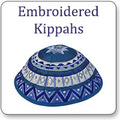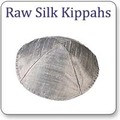 Loading... Please wait...
Loading... Please wait...Categories
- Books
- Judaica
- Jewish Holidays
- Judaica Art
- Judaica Bags
- Judaica Blessing
- Judaica Dancers
- Judaica Metal Stands
- Judaica Paper Mache
- Judaica Pomegranates
- Judaica Trivet
- Judaica Wall Hanging
- Salt & Pepper Shakers
- Judaica Flowers
- Judaica Hearts
- Judaica Jazz
- Judaica Heads
- Oil Shofars
- Judaica Bicycle Riders
- Judaica Cows
- Judaica Brooches
- Judaica Butterflies
- Judaica Birds
- Judaica Bowls
- Brooches
- Judaica Key Rings
- Judaica Jewelry
- Judaica Artists
Kippah For Sale
The kippah for sale (yarmulke), the Jewish skullcap, is usually worn by men in synagogue, by Orthodox men the whole day, and in a few newer circles even by women. Here you will see both common and modern designs in natural cotton, silk, suede, silk, and more. Take a peek around -- you will see the perfect kippah for just about any person and most occasions!
A kippah is the Hebrew term for skullcap, also described in Yiddish as a yarmulke, or less frequently as a Koppel.
Jewish rules require men to repay their mind as an indicator of admiration and reverence for God when praying, learning Torah, stating a blessing or coming into a synagogue.
This practice has its origins in biblical times when the priests in the Temple were instructed to pay their heads.
Customarily, Jewish men and children wear the kippah all the time, a symbol of their knowledge of, and distribution to, a "higher" entity. One of the examples where men have to wear a kippah is while blowing the shofar in Higher Holidays. The shofar, comes in different shapes and forms, the most known one being the Yemenite shofar. Another example could during the holiday Hanukkah when every evening each family lights the candles of the 9 branch menorah which for itself comes in different shapes and colors.
Though it is not explicitly required for legal reasons, the practice is mentioned in the Talmud, and through the age ranges, this became a recognized Jewish custom to the idea that in line with the most halachic regulators, it is essential. You need to, therefore, not walk or even remain, bareheaded. Small kids also need to be taught to repay their heads.
Different types of kippahs
Apart from the common dark-colored kippah, many wear kippot (plural form of kippah) of varied colors or designs. Some areas are suffering from kippah designs that are highly complex artwork, such as those created by Jewish artisans from Yemen and Georgia, almost all of whom now are in Israel.
Kippah for sale (skullcap or yarmulke) is a tiny hat or mind covering. In traditional Jewish neighborhoods, only men wear kippot (the plural of kippah), and they're worn all the time (except when sleeping and bathing). In non-Orthodox neighborhoods, some women also wear kippot, and folks have different traditions about when to wear a kippah -- when eating, praying, learning Jewish text messages, or going into a sacred space like a synagogue or cemetery. The Reform activity has historically been against wearing kippot, however, in modern times it is becoming more prevalent and accepted for Reform women and men to hide their mind during prayer and Jewish analysis.
There is absolutely no halachic requirement to protect one's brain, but it is known as an indicator of reverence for God. Keeping the top covered all the time has mystical value, and because of this a lot of people cover their mind double -- a head wear on the kippah, or a tallit (prayer shawl) over the kippah --while praying.
Kippah and other Judaica are available for sale at www.judaicamore.com .








 Our newsletter
Our newsletter